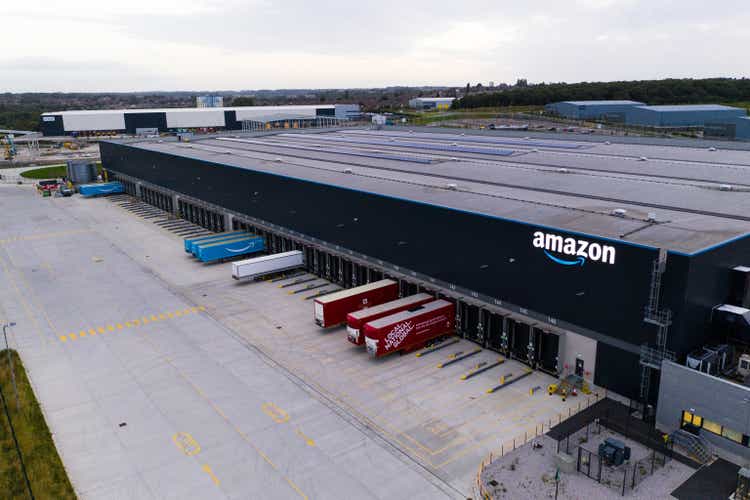Teamjackson
Amazon.com, Inc. (NASDAQ:AMZN) will be releasing 3Q22 results at 5:30pm Eastern Time on 10/27. In 2Q22, Amazon delivered better-than-feared results where total revenue of $121 billion grew 7% YoY and adjusted EPS of $0.1 came in above $0.13 consensus. For 3Q22, management guided revenue of between $125 and $130 billion (above $126.5 consensus), implying a 15% YoY growth thanks to Prime Day in Q3. The Street consensus of $127.6 is roughly at the midpoint of guidance.
Amazon also guided Q3 operating margin of between $0 and $3.5 billion, which roughly comes down to an EBIT margin of 1.4% at the midpoint. The Street has a consensus of roughly $3 billion and 2.4% EBIT margin, implying some conservatism on Amazon’s guide. However, investors should brace for any potential weakness in Amazon’s e-commerce business.
North America will likely meet expectations thanks to Prime Day
Street estimates call for Amazon’s Q3 North America (NA) revenue of $76 billion, implying a YoY growth of 16%. According to advance monthly retail sales data released by the US Census Bureau, September non-store retail sales grew 11.6% YoY and 0.5% MoM. In Q3 (July to September), non-store retail sales grew 13.8% YoY / 2.8% QoQ. While these figures cannot help us forecast Q3 NA sales with 100% accuracy, they should give us a sense of how the U.S. e-commerce sector has been performing as of late.
Amazon’s Prime Day took place in Q3 this year vs. Q2 in 2021, which likely provided a few points of top-line growth in 3Q22. In 2021, Prime Day contributed 4% of YoY growth. If we were to use the U.S. Census Bureau’s Q3 non-store sales growth of 13.8% as a proxy and assume a similar level of contribution from Prime Day in 2Q21, Amazon’s 3Q22 NA revenue should come in slightly above consensus at $77 billion.
Margin-wise, analysts are expecting a NA EBIT margin of 0%. This would represent an improvement from negative 1%/2% in Q2/Q1. In Q1, Amazon highlighted ~$6 billion in incremental costs from higher logistics costs, overstaffing, and warehouse overcapacity. In Q2, these incremental expenses were reduced to $4 billion as management said it would continue to rightsize its capacity. Already, Amazon has closed or delayed 66 facilities including fulfillment centers and delivery stations, a positive from a margin-perspective.
But International will likely face pressure
While NA results would likely be inline with consensus estimates, International may be an area that makes investors nervous about Amazon’s e-commerce business. Based on consensus estimates, the Street is expecting Q3 International revenue growth of just 2% and EBIT margin of -6%.
Europe has been hit particularly hard by the Russian-Ukraine crisis and significantly higher energy costs may have weighed heavily on Q3 results as the UK and Germany are two of Amazon’s largest markets outside North America. Additionally, a much stronger USD would also impact top-line growth easily by 3 to 5 points in Amazon’s three biggest international markets (the UK, Germany, and Japan).
Historically, Amazon’s International segment has been a drag on margins. While International delivered positive EBIT margins during the pandemic as demand skyrocketed, margins started turning negative from 3Q21 and has been deep in the red since. In 1H22, International had an operating loss of $3 billion as revenue declined by 9%. For 2H22, the Street is expecting another loss of ~$3 billion on mid-single-digit top-line growth, while NA margin is expected to turn positive on double-digit growth.
A second Prime Day?
Amazon just had another Prime Day on 10/11 and 10/12 after one in July. The implication is negative since Amazon has never hosted the event twice in the same year. In recent years, it’s become a common practice for retailers to start running promotional events before Black Friday and Cyber Monday (typically in November and December).
By doing another Prime Day in October, Amazon was clearly playing into this trend, but investors should take this as a sign of a challenging e-commerce landscape characterized by excess inventory, rising inflation, and slower spending on consumer goods post-Covid. Though Amazon believes demand would grow into capacity during the holiday season, a second Prime Day in the current quarter may ignite skepticism on whether management’s initial assumption was too optimistic.
Final thoughts
As much as Amazon has a robust cloud business where AWS is still expected to deliver resilient growth and enviable margins, Amazon’s e-commerce exposure (>80% of revenue) could still weigh on investor sentiment as margins could still be challenged by the current macro conditions. While North America may see some improvement, International performance might remain muted due to an energy crisis in Europe that crimps consumption and a much stronger dollar. As a result, I see limited upside to consensus estimates going into Amazon’s Q3 print, and would refrain from trading earnings in light of an unfavorable risk/reward profile.


Be the first to comment